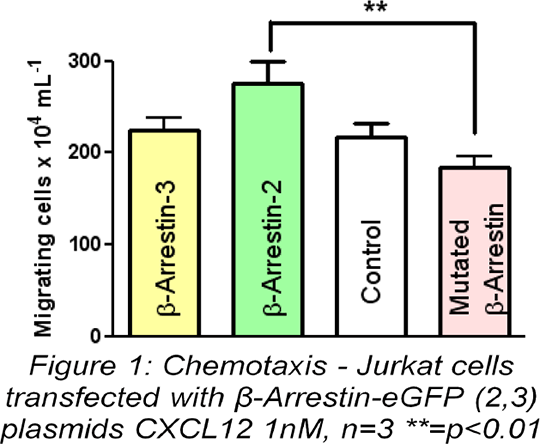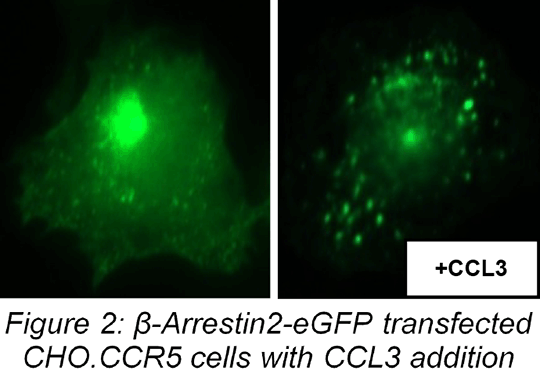Signalling Pathway Proteins In CC and CXC Chemokine-Induced Chemotaxis Receptors CXCR4 and CCR5 and their respective ligands chemokines CXCL12 and CCL3 are important for the survival and invasiveness of leukaemic B-cells (1). The aim was to elucidate chemokine signalling pathways triggered by either CCL3 or CXCL12. Methodology employed chemotaxis assays with 5μM ChemTx® plates, CXCL12 or CCL3, and 30 minutes’ pre-treatment of cells with small molecule inhibitors (table 1), and also β-Arrestin-eGFP plasmid transfection of Jurkat cells followed by chemotaxis (figure 1), and of Chinese Hamster Ovary cells (CHO) expressing CCR5 revealed by UV microscopy (figure 2).
CXCR4 and CCR5 signalling may involve calcium release (4), heterotrimeric G-proteins (5), β-arrestins and dynamin (6). There appear distinct differences in the importance of key signalling proteins between CXCR4 and CCL3 ligand stimulation of receptors. PI3K can activate many signalling proteins deregulated in cancers; these offer possible therapeutic targets. PI3K inhibition prevents migration towards CXCL12 more in Jurkat than THP-1 (table 1) possibly because Jurkat lack the negative regulators of PI3K, tumour suppressors PTEN and SHIP, hence have constitutively active PI3K. This appears not the case in monocytic THP-1. Rac1 or Focal Adhesion Kinase (FAK) inhibition (table 1) or β-arrestin mutation (figure 1) reduces CXCL12-triggered chemotaxis, whereas β-arrestin-2 but not β-arrestin-3 overexpression increases CXCL12-triggered migration in Jurkat (figure 1). FAK silencing has previously been shown to abolish leukaemic cell responses to CXCL12, and Rac1 purportedly mediates actin dynamics essential for metastatic cell motility and invasive responses activated by CXCL12. In contrast CCL3-responsive receptors may require involvement of β-arrestin (figure 2), a functional dynamin GTPase domain (6) (table 1), and activation of Rho-associated protein kinase (4), but appear unaffected by Rac1, PI3K or FAK inhibition (table 1). In conclusion, cell signalling responses by chemokine receptors can be cell type-specific, but investigations reveal distinct differences between CXCR4 and CCR5 signalling pathways. |
|





